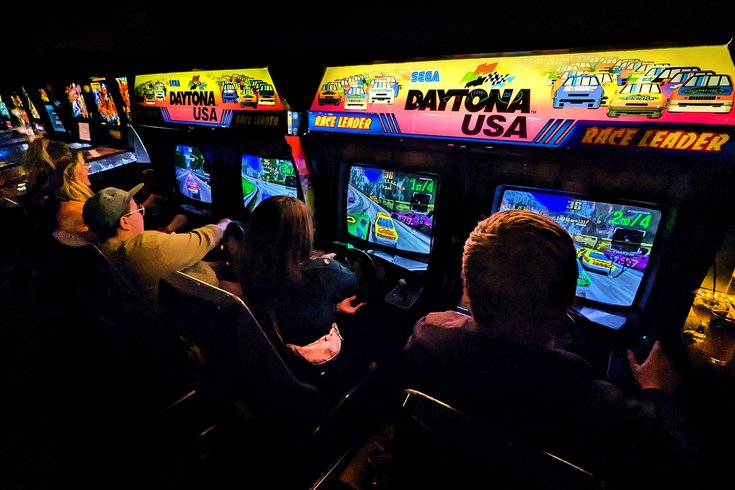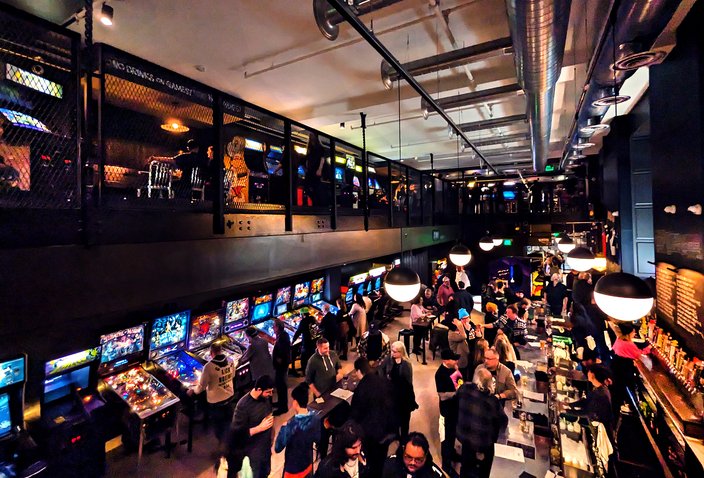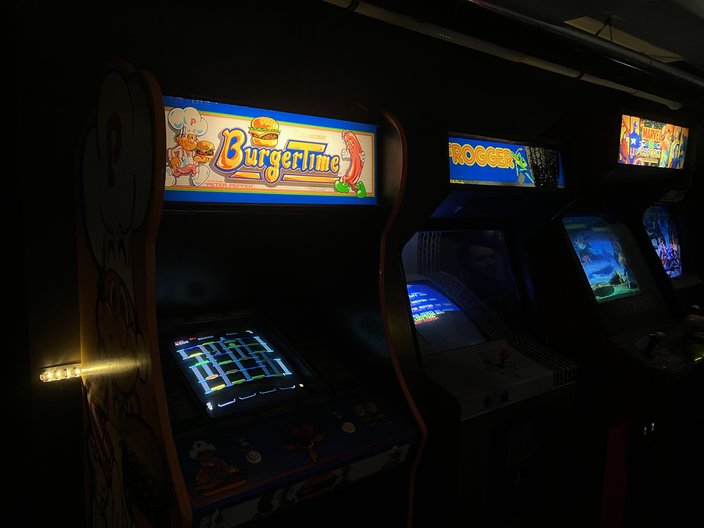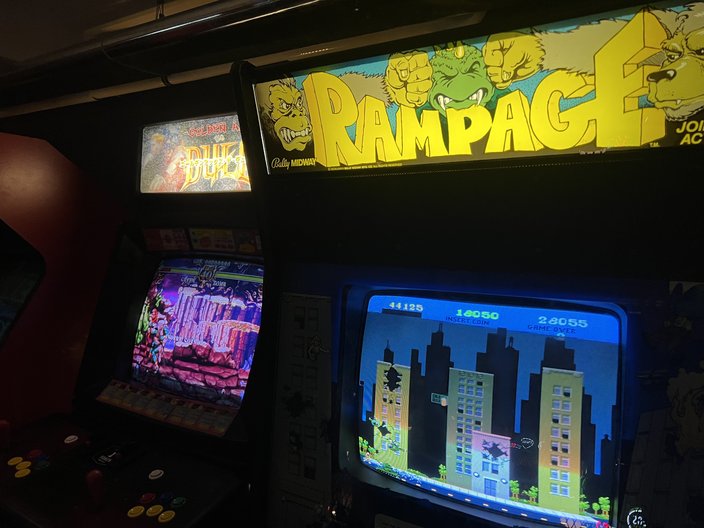
January 12, 2024
 Nick Duke/Barcade
Nick Duke/Barcade
Daytona USA allows four players to race against each other simultaneously; the Center City Barcade is the only Barcade that currently houses this game.
When you enter the new Barcade in Center City, you'll notice some of the usual classic video games: "Ms. Pac-Man," "Donkey Kong," a variation of Tetris and others. But amid the loud noise from pinball machines, arcade cabinets and patrons at the bar are several unusual and obscure games that Barcade owner Paul Kermizian takes pride in including.
The Center City Barcade is the second Philadelphia location for the retro video-game bar; the other is in Fishtown. There are over 80 arcade and pinball games filling the two-floor space inside the historic Hale Building, at 1326 Chestnut St.
To Kermizian, the lineup at each Barcade — there are seven others in the U.S. plus the two here — represents a history of classic gaming. Patrons at the bar-meets-arcade can expect to see genres like racing, beat-em-up, side-scrolling, sports and shooting games at any of the locations. But Kermizian's enthusiasm is evident when he talks about "weirdo unusual games" like "Pepper II," "Slither" and "Anteater." "They don't make money for us, but you don't see them anywhere else."
Barcade owns and maintains all of its games, with the managers at each bar trained to maintain and fix them when needed. The business also carefully curates each location's game lineup, with machines occasionally rotating among different bars and its storage-space shop in New Jersey. "It's like a big puzzle," Kermizian said about the decision process behind replacing one game with another. For example, "Mr. Do" is at the Center City location, but should it leave, Barcade would probably replace it with something like "Dig Dug"; both games have digging as a central feature.
The wooden aesthetic of the Center City Barcade is similar to more recent Barcade locations such as one in Detroit, and is an attempt to work with the “character” and history of the Hale Building.
Whether a game stays or leaves depends on its demand and popularity; if one particular game in Center City proves to be a draw, it'll likely stay. And Barcade isn't afraid to experiment, even 20 years after opening its first location in Brooklyn. Modern Japanese rhythm games, like "Groove Coaster," made the lineup at Center City. The addition of rhythm games is a recent development of Barcade — just don't expect mainstream titles, like "Guitar Hero," to show up.
The timeline for establishing the new Center City location was lengthy. After finally landing on the Hale Building for the bar's home during the COVID-19 pandemic, delays in the zoning process slowed down Kermizian and the Barcade team. Eight months in the zoning queue from late 2022 to the middle of 2023 concluded with "two-minute meeting" to approve the location's final plans, Kermizian said.
Not long after the opening of the Center City Barcade in early January, I checked out the new location and got my hands on as many games as possible. To play the games, customers by tokens with cash — one token costs 25 cents, and the video games mostly cost between one and three tokens to play.
Among the mix of classic titles and those weird obscure ones that Barcade champions, these are the ones that stood out:
A very recognizable name in the history of arcade games, "Asteroids" has a simple premise: You navigate a triangle-shaped spacecraft shooting at dangerous incoming asteroids that split into smaller space rocks with each hit until they're all finally obliterated. What makes this game stand out are its visuals: the "Asteroids" arcade cabinet uses a vector display instead of pixelated graphics. Each object is made of drawn lines rather than a series of tiny illuminated dots.
This results in objects that pop from the display with bright white outlines, creating a distinctly smooth feeling and look that most games of its time did not have. And "Asteroids" is still addictive decades after it was released by Atari in 1979; check to see if my high score is still on the leaderboard under the initials "CJC."
The classic arcade game BurgerTime is at several Barcade locations. But in Philadelphia, only the Center City Barcade location contains the chaotic platforming maze game.
Keeping up with orders at a restaurant is already frantic enough, but "BurgerTime" adds the peril of anthropomorphic hot dogs, pickles and fried eggs chasing and attacking chef character Peter Pepper, who you control in an attempt to assemble giant hamburgers. Peter Pepper runs a maze of platforms, having to step on each buns, hamburger patties and veggies to get them to fall and stack into burgers.
As you climb ladders and avoid the food monsters, you'll realize that "BurgerTime" is a puzzle, of sorts. While players might try to make their burgers as fast as possible, it's also about outmaneuvering enemies and timing your actions so that ingredients fall on top of them. "BurgerTime" was created by Data East in 1982.
As a taxi driver in Sega's madcap driving game, you'll pick up passengers and take them to their destinations. But as the adjective in the title implies, you're anything but a conventional cabbie. You'll frantically drive in between other cars, swerve on the wrong side of the road and even do some excessive stunt jumps cruising the streets of a San Francisco-like metropolitan area.
The urgent nature of "Crazy Taxi," which arrived in arcades in 1999, drives the player to act as recklessly as possible, with comedic results. "Crazy Taxi" is certainly a product of its time, even including blatant product placement from brands like Pizza Hut and KFC. Sega is working on a new Crazy Taxi game, but it's a strange sell with Uber and Lyft having a stronghold on the taxi business today.
While Namco properties such as "Pac-Man" took off, others like "Mappy" — released in 1983, three years after "Pac-Man" — gathered dust in the company's back catalog. It's a shame because "Mappy" offered a different take on the same frantic gameplay of "Pac-Man," featuring a literal cat-and-mouse scenario. As a police officer mouse named Mappy, players will scurry through a mansion to retrieve stolen goods while avoiding cats.
It's one of Kermizian's favorites and the first arcade cabinet he had ever bought, he said. We see why, as it's quite fun to navigate the mansion through doors and trampolines. Once it clicks that cats can't harm you while you're in the air, and how easily you can go to any floor of the mansion, it's nearly impossible to stop playing "Mappy."
Rampage from now-defunct studio Midway has players take control of one to three destructive and giant animals, with the main goal of reducing all buildings to rubble.
Some video games appeal to our most basic instincts, and "Rampage," released in 1986 by Midway, is certainly one of them. Players choose to take control of an oversized gorilla (named George), wolf (Ralph) or lizard (Lizzie) with the task of smashing every building, vehicle and person they see. These monstrous animals can climb buildings and wreak even more havoc from a height.
Even though "Rampage" isn't a household video game name, the property somehow turned into an action movie starring Dwayne Johnson in 2018. If you ask anyone, however, the classic arcade game holds up much better.
 Nick Duke/Barcade
Nick Duke/Barcade Chris Compendio/for PhillyVoice
Chris Compendio/for PhillyVoice Chris Compendio/for PhillyVoice
Chris Compendio/for PhillyVoice